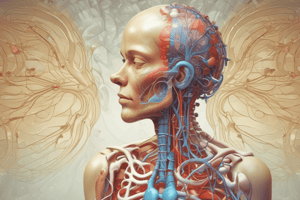Podcast
Questions and Answers
Where does the exchange of gases occur between the alveoli and blood capillaries?
Where does the exchange of gases occur between the alveoli and blood capillaries?
- In the lungs (correct)
- In the pharynx
- In the upper respiratory tract
- In the lower respiratory tract
What is the name of the protein in red blood cells that binds oxygen?
What is the name of the protein in red blood cells that binds oxygen?
- Carbonic acid (H2CO3)
- Haemoglobin (Hb) (correct)
- Bicarbonate ions (HCO3-)
- Oxyhaemoglobin (HbO2)
What is the process by which oxygen is transported from the lungs to body tissues?
What is the process by which oxygen is transported from the lungs to body tissues?
- Diffusion
- Internal respiration
- External respiration
- Oxygen binding to haemoglobin (correct)
What is the term for the movement of air in and out of the lungs?
What is the term for the movement of air in and out of the lungs?
What is the term for the blood flow through the lungs?
What is the term for the blood flow through the lungs?
How many forms can carbon dioxide be transported in?
How many forms can carbon dioxide be transported in?
Flashcards are hidden until you start studying
Study Notes
Exchange Of Gases
- Occurs in the lungs between the alveoli and blood capillaries
- External respiration: oxygen in, carbon dioxide out
- Internal respiration: oxygen out, carbon dioxide in
Oxygen Transport
- Oxygen binds to haemoglobin (Hb) in red blood cells
- Forms oxyhaemoglobin (HbO2)
- Oxygen is transported from lungs to body tissues
- Partial pressure of oxygen (pO2) affects binding:
- High pO2: oxygen binds to Hb
- Low pO2: oxygen released from Hb
Carbon Dioxide Transport
- Carbon dioxide is transported in three forms:
- Dissolved CO2: in plasma
- Bicarbonate ions (HCO3-): formed in red blood cells
- Carbonic acid (H2CO3): formed in red blood cells
- Carbon dioxide is transported from body tissues to lungs
Gas Exchange Mechanisms
- Diffusion: gas exchange between alveoli and blood capillaries
- Ventilation: movement of air in and out of lungs
- Perfusion: blood flow through lungs
Respiratory System
- Upper respiratory tract:
- Nose and mouth
- Pharynx
- Larynx
- Lower respiratory tract:
- Trachea
- Bronchi
- Bronchioles
- Alveoli
Haemoglobin Binding
- Haemoglobin (Hb): protein in red blood cells that binds oxygen
- Oxyhaemoglobin (HbO2): oxygen-bound haemoglobin
- Bohr effect: decrease in pH increases oxygen release from Hb
- Haldane effect: increase in CO2 increases oxygen release from Hb
Exchange Of Gases
- Occurs in lungs between alveoli and blood capillaries, with oxygen in and carbon dioxide out in external respiration, and oxygen out and carbon dioxide in during internal respiration
Oxygen Transport
- Oxygen binds to haemoglobin (Hb) in red blood cells, forming oxyhaemoglobin (HbO2)
- Oxygen is transported from lungs to body tissues
- Partial pressure of oxygen (pO2) affects binding, with high pO2 promoting oxygen binding to Hb and low pO2 promoting oxygen release from Hb
Carbon Dioxide Transport
- Carbon dioxide is transported in three forms: dissolved CO2 in plasma, bicarbonate ions (HCO3-) formed in red blood cells, and carbonic acid (H2CO3) formed in red blood cells
- Carbon dioxide is transported from body tissues to lungs
Gas Exchange Mechanisms
- Diffusion: gas exchange between alveoli and blood capillaries
- Ventilation: movement of air in and out of lungs
- Perfusion: blood flow through lungs
Respiratory System
- Upper respiratory tract consists of nose and mouth, pharynx, and larynx
- Lower respiratory tract comprises trachea, bronchi, bronchioles, and alveoli
Haemoglobin Binding
- Haemoglobin (Hb) is a protein in red blood cells that binds oxygen
- Oxyhaemoglobin (HbO2) is oxygen-bound haemoglobin
- Bohr effect: decrease in pH increases oxygen release from Hb
- Haldane effect: increase in CO2 increases oxygen release from Hb
Studying That Suits You
Use AI to generate personalized quizzes and flashcards to suit your learning preferences.




